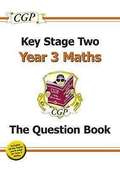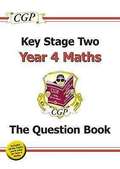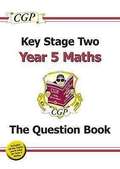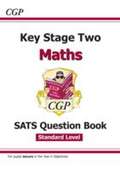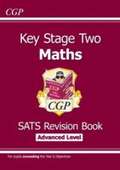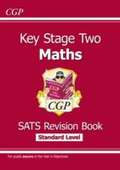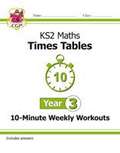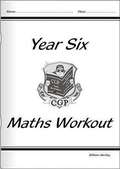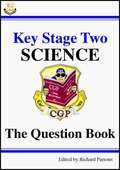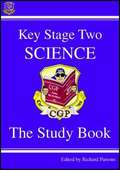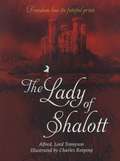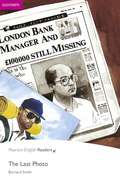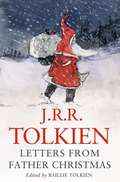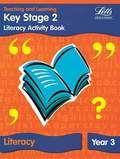- Table View
- List View
KS2 Maths Targeted Question Book - Year 3 (PDF)
by Cgp BooksThis book contains a variety of question types covering all the maths topics in the National Curriculum for 7-8 year olds. It's written in a straightforward, approachable style, with clear learning objectives on each page.
KS2 Maths Targeted Question Book - Year 4 (PDF)
by Cgp BooksBursting with test-style practice questions for Year 4 Maths, this smashing book is fully up-to-date for the new curriculum! There’s a section of questions for each topic, with space on each page for children to write their answers and any working out, plus mark-scheme boxes in the margin so that you can keep track of their progress (answers are included at the back). The book also contains two Objectives Tests — one at the start of the book that recaps the Year 3 skills, and one at the end that covers a mixture of topics from Year 4. Matching study notes are available in our Year 4 Targeted Study Book.
KS2 Maths Targeted Question Book - Year 5 (PDF)
by Cgp BooksCovers various topics kids learn about during their Year 5 Maths lessons at school. This book includes practice questions in a variety of styles. It is suitable for 9 to 10-year-olds.
KS2 Maths Targeted SATs Question Book: For tests in 2018 and beyond (CGP KS2 Maths SATs)
by Cgp BooksKS2 Maths Targeted SATs Question Book - Advanced. Revision guide 9781782944188
KS2 Maths Targeted SATs Question Book - Standard (PDF)
by Cgp BooksKS2 Maths Targeted SATs Question Book - Standard
KS2 Maths Targeted SATs Revision Book - Advanced (PDF)
by Cgp BooksKS2 Maths Targeted SATs Revision Book - Advanced
KS2 Maths Targeted SATs Revision Book - Standard (PDF)
by Cgp BooksKS2 Maths Targeted SATs Revision Book - Standard
KS2 Maths: Times Tables 10-Minute Weekly Workouts - Year 3
by Cgp Books"This amazing CGP Workbook is full of test-style practice questions for every Year 3 Maths topic. It’s all set at an accessible level - perfect for pupils who are still getting to grips with the basics. We’ve colour coded the questions to show level of difficulty, and have included full answers for every question - ideal for practice at home. Also available is a fantastic matching Study Book (9781847621900) "
KS2 Maths Workout Year 6 (for the New Curriculum) (PDF)
by Cgp BooksPacked with Numeracy practice for Year 6 of Primary School, this Maths Workout book contains lots of quick-fire questions to test children's knowledge. Part of a set of quick-practice books for the whole of Primary School from Reception to Key Stage 1 and Key Stage 2, each book comes complete with answers. It provides excellent value, and is ideal for working through at home to supplement school Numeracy lessons and reinforce children's understanding of topics.
KS2 Science: The Question Book (PDF)
by Cgp BooksThis book is packed with helpful practice questions for Key Stage Two Science - all fully up-to-date for the new curriculum for 2014 and beyond. There’s a range of questions for each topic, covering Living Things, Materials & Their Properties and Physical Processes. Answers are included in a pull-out section for easy marking. Matching study notes are also available in CGP’s KS2 Science Study Book - see 9781841462509.
KS2 Science Study Book
by Cgp BooksThis friendly, colourful book explains every Science topic children will need to understand for Key Stage Two (ages 7-11). Each section is packed with clear, easy-to-read study notes, along with plenty of helpful tips and examples. In addition, there are quick recap questions throughout the book to help make sure children have mastered the essential skills. For even more practice, a CGP KS2 Science Question Book is also available - see 9781841462592.
The Lady of Shalott (PDF)
by Alfred Tennyson TennysonTennyson's romantic poem, full of atmosphere and emotion, tells the story of the mysterious Lady of Shalott. In this exquisite illustrated edition, Charles Keeping's evocative pictures take us to Camelot, a fabled world of knights and castles, to witness the cursed life and tragic death of a beautiful but doomed maiden. This new edition features rescanned artwork to capture the inspiring detail of Keeping's illustrations and a striking new cover.
The Last Photo (Penguin Readers) (PDF)
by Bernard SmithPam and Martin visit Cambridge. Pam takes a photo, but a man walks in front of her. Later Martin sees a picture of a man in a newspaper. The police want this man. Is he the same man? And where is he now? Does Pam's photo have the answers?
Legends of the Lake (Rigby Navigator)
by Rosalind Kerven Jenny Nimmo Geraldine Mccaughrean3 short stories for guided reading: The Enchanted Lake by Rosalind Kerven: Donn finds an enchanted lake with a beautiful but sad mermaid. Can Donn help save her from the wizardâ TMs spell?, Loch Ness by Geraldine McCaughrea: One day Meg forgets to replace the lid of the village well and releases its magic, The Lady of the Lake by Jenny Nimmo: Gwyn, a lonely Welsh shepherd, marries the magical lady of the lake but she warns him that her ways are different.
Letang a Sioned yn Dod i'r Adwy
by Beverley Naidoo Sian Vaughan Evans DaviesStori ddeniadol a lliwgar arall mewn cyfres o lyfrau darllen ar gyfer disgyblion Cyfnod Allweddol 2, yn adrodd hanes y ffrindiau Letang a Sioned yn achub eu cyd-ddisgyblion rhag teirw ifanc yn ystod taith gerdded natur. [A Welsh adaptation of Letang and Julie Save the Day, a clearly written and colourfully illustrated story about Letang and Sioned saving their class-mates from some young bulls on a nature study walk, aimed at Key Stage 2 pupils.] Datganiad hawlfraint Gwneir y copi hwn dan dermau Rheoliadau (Anabledd) Hawlfraint a Hawliau mewn Perfformiadau 2014 i'w ddefnyddio gan berson sy'n anabl o ran print yn unig. Oni chaniateir gan gyfraith, ni ellir ei gopïo ymhellach, na'i roi i unrhyw berson arall, heb ganiatâd.
Letters from Father Christmas (PDF)
by J. R. R. TolkienThe first ever B-format edition of Tolkien's complete Father Christmas letters, including a new introduction and rare archive materials.
Letts Key Stage 2 Literacy Activity Book: Year 3 (PDF)
by Barker, Ray|Fidge, LouisThis Literacy Activity Book covers of a wide range of texts, both fiction and non-fiction, in line with the National Literacy Strategy Framework. Structured pupil books that are easy to navigate Can be used alongside other classroom resources Popular scheme used in many Primary Schools
Life Cycle of a frog 1 of 5 (Frog ovum development) (UEB Contracted)
This page with five images illustrates stages in the development of a frog ovum. There is a locator dot shown, which will be at the top left of the page when the image is the right way up. The ovum is surrounded by a mass of jelly yolk, which is not shown. The top left of the page shows the zygote stage: a single cell with one nucleus at its centre, indicated by a dot. To the right of this is the cell in the process of division; it now has two nuclei. In the centre left of the page is the four cell stage with four separate cells, each with its own nuclei. Down the page from this the cells have divided again and now number sixteen. The bottom right section of the page shows the blastocyst stage. The cells have divided yet again and have formed a ball with a hollow containing fluid at its centre. There is a scale at the bottom of the page showing its actual size.
Life Cycle of a frog 1 of 5 (Frog ovum development) (UEB Uncontracted)
This page with five images illustrates stages in the development of a frog ovum. There is a locator dot shown, which will be at the top left of the page when the image is the right way up. The ovum is surrounded by a mass of jelly yolk, which is not shown. The top left of the page shows the zygote stage: a single cell with one nucleus at its centre, indicated by a dot. To the right of this is the cell in the process of division; it now has two nuclei. In the centre left of the page is the four cell stage with four separate cells, each with its own nuclei. Down the page from this the cells have divided again and now number sixteen. The bottom right section of the page shows the blastocyst stage. The cells have divided yet again and have formed a ball with a hollow containing fluid at its centre. There is a scale at the bottom of the page showing its actual size.
Life Cycle of a frog 2 of 5 (Frog spawn development) (Large Print)
On this page there are three images showing frog spawn development. There is a locator dot shown, which will be at the top left of the page when the image is the right way up. At the top of the page is the blastocyst surrounded by the jelly yolk in which it will develop. At the centre of the page is an image of the embryo stage; the cells are beginning to arrange themselves into the different areas that will become limbs and organs. The image at the bottom of the page shows a tadpole, still in the egg and surrounded by yolk, but ready to hatch. It has a scale to its right showing approximate size.
Life Cycle of a frog 2 of 5 (Frog spawn development) (UEB Contracted)
On this page there are three images showing frog spawn development. There is a locator dot shown, which will be at the top left of the page when the image is the right way up. At the top of the page is the blastocyst surrounded by the jelly yolk in which it will develop. At the centre of the page is an image of the embryo stage; the cells are beginning to arrange themselves into the different areas that will become limbs and organs. The image at the bottom of the page shows a tadpole, still in the egg and surrounded by yolk, but ready to hatch. It has a scale to its right showing approximate size.
Life Cycle of a frog 2 of 5 (Frog spawn development) (UEB Uncontracted)
On this page there are three images showing frog spawn development. There is a locator dot shown, which will be at the top left of the page when the image is the right way up. At the top of the page is the blastocyst surrounded by the jelly yolk in which it will develop. At the centre of the page is an image of the embryo stage; the cells are beginning to arrange themselves into the different areas that will become limbs and organs. The image at the bottom of the page shows a tadpole, still in the egg and surrounded by yolk, but ready to hatch. It has a scale to its right showing approximate size.
Life Cycle of a frog 3 of 5 (Tadpole development) (Large Print)
This is a multi-page image of the four stages of tadpole development, set on two pages. There are locator dots shown, which will be at the top left of each page when the images are the right way up. Each illustration has a scale showing its approximate size. Page 1: This page shows two illustrations of a tadpole with its head to the right of the page and its tail to the left. It is shown from the side so only one eye can be found. At the top of the page the tadpole is at an early stage of development. It still has gills to get its oxygen from the water, one of which can be found just to the left of its eye. At the bottom of the page the tadpole has grown and lost its gills. It has now developed so that it can breathe air through its mouth. Page 2: This page shows two more stages of development of the frog tadpole with its head to the right and tail to the left. At the top of the page the tadpole is viewed from the side with only one eye visible. One of its recently formed back legs can be found along the bottom edge of its body and the little bud of one of the emerging front legs can be found to the left of its mouth. At the bottom of the page the tadpole is seen from above. At the right of the image both of the tadpoles eyes are on view. To the left of this its front legs can be found and further left its back legs and tail. It is beginning to change from its 'fishy' shape to one that is more froglike.
Life Cycle of a frog 3 of 5 (Tadpole development) (UEB Contracted)
This is a multi-page image of the four stages of tadpole development, set on two pages. There are locator dots shown, which will be at the top left of each page when the images are the right way up. Each illustration has a scale showing its approximate size. Page 1: This page shows two illustrations of a tadpole with its head to the right of the page and its tail to the left. It is shown from the side so only one eye can be found. At the top of the page the tadpole is at an early stage of development. It still has gills to get its oxygen from the water, one of which can be found just to the left of its eye. At the bottom of the page the tadpole has grown and lost its gills. It has now developed so that it can breathe air through its mouth. Page 2: This page shows two more stages of development of the frog tadpole with its head to the right and tail to the left. At the top of the page the tadpole is viewed from the side with only one eye visible. One of its recently formed back legs can be found along the bottom edge of its body and the little bud of one of the emerging front legs can be found to the left of its mouth. At the bottom of the page the tadpole is seen from above. At the right of the image both of the tadpoles eyes are on view. To the left of this its front legs can be found and further left its back legs and tail. It is beginning to change from its 'fishy' shape to one that is more froglike.
Life Cycle of a frog 3 of 5 (Tadpole development) (UEB Uncontracted)
This is a multi-page image of the four stages of tadpole development, set on two pages. There are locator dots shown, which will be at the top left of each page when the images are the right way up. Each illustration has a scale showing its approximate size. Page 1: This page shows two illustrations of a tadpole with its head to the right of the page and its tail to the left. It is shown from the side so only one eye can be found. At the top of the page the tadpole is at an early stage of development. It still has gills to get its oxygen from the water, one of which can be found just to the left of its eye. At the bottom of the page the tadpole has grown and lost its gills. It has now developed so that it can breathe air through its mouth. Page 2: This page shows two more stages of development of the frog tadpole with its head to the right and tail to the left. At the top of the page the tadpole is viewed from the side with only one eye visible. One of its recently formed back legs can be found along the bottom edge of its body and the little bud of one of the emerging front legs can be found to the left of its mouth. At the bottom of the page the tadpole is seen from above. At the right of the image both of the tadpoles eyes are on view. To the left of this its front legs can be found and further left its back legs and tail. It is beginning to change from its 'fishy' shape to one that is more froglike.
